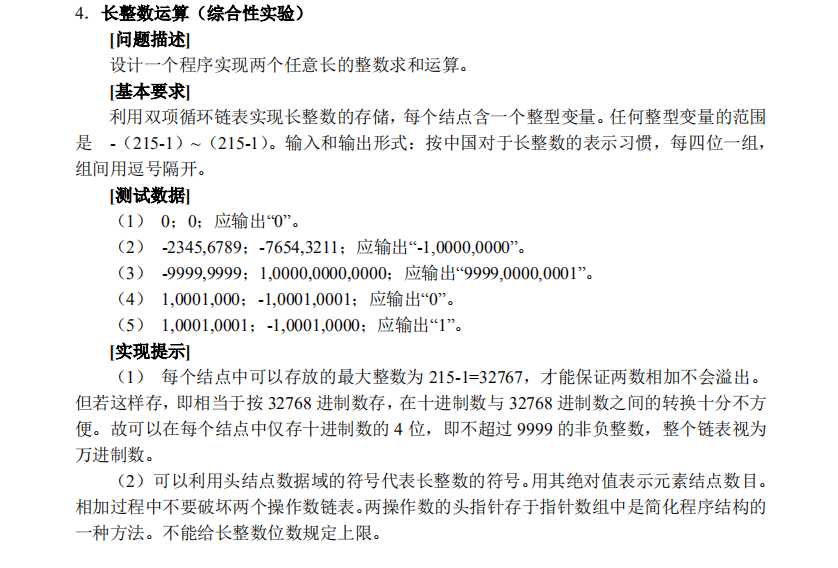长整数运算
Posted cuteythyme
tags:
篇首语:本文由小常识网(cha138.com)小编为大家整理,主要介绍了长整数运算相关的知识,希望对你有一定的参考价值。

这是一道用链表实现大整数相加的题目,就是模拟加法和减法的过程,思路是很简单的,但是过程还是有些麻烦的。
写的过程也有很多小错误,通过运用测试集不断调试,最后终于写好了,自己完完整整写下来还是花了好几个小时的。
#include<stdio.h> #include<stdlib.h> #include<string.h> #include<math.h> #define Max_size 100 /*测试样例 输入: 0; 0; 输出: 0 输入: -2345,6789; -7654,3211; 输出:-1,0000,0000 输入: -9999,9999; 1,0000,0000,0000; 输出: 9999,0000,0001 输入: 1,0001,0001; -1,0001,0001; 输出:0 输入: 1,0001,0001; -1,0000,0000; 输出:1 */ //利用双向循环链表实现长整数的存储 typedef struct Node { int data; struct Node *prior; struct Node *next; }DoubleNode,*DoubleList; DoubleList InitList(); void Insert(DoubleList *L,int number); void Readnumber(DoubleList *L); int Length(DoubleList L); void Add(DoubleList L1,DoubleList L2,DoubleList *L3); void Minus(DoubleList L1,DoubleList L2,DoubleList *L3); int Operation(DoubleList L1,DoubleList L2,DoubleList *L3); int Size(DoubleList L1,DoubleList L2); void Print(DoubleList L); int main(void) { DoubleList L1=InitList(); DoubleList L2=InitList(); printf("Enter the first integer(each four bits a group,separated by a comma): "); Readnumber(&L1); int len1=Length(L1); printf("Enter the first integer(each four bits a group,separated by a comma): "); Readnumber(&L2); int len2=Length(L2); /*printf("%d %d",len1,len2); printf(" "); int size=Size(L1,L2); printf("%d",size); printf(" ");*/ DoubleList L3=InitList(); printf("Add results: "); int sign=Operation(L1,L2,&L3); if(sign==-1) printf("%c",‘-‘); Print(L3); return 0; } //建立一个带有头结点的空循环双链表 DoubleList InitList() { DoubleList L=(DoubleList)malloc(sizeof(DoubleNode)); L->prior=L; L->next=L; return L; } //插入结点时,让链表的高位在链表的尾部,低位在链表的头部 void Insert(DoubleList *L,int number) { DoubleNode *p=(DoubleNode*)malloc(sizeof(DoubleNode)); p->data=number; p->next=(*L)->next; (*L)->next->prior=p; (*L)->next=p; p->prior=*L; } //读取输入的整数,每四个数字存放在一个节点中 void Readnumber(DoubleList *L) { int number,i=0; char c; scanf("%d%c",&number,&c); while(1) { if(number<0&&i==0) { (*L)->data=-1; number=abs(number); Insert(L,number); } else if(number>=0&&i==0) { (*L)->data=1; Insert(L,number); } else if(number>=0&&i!=0) Insert(L,number); if(c==‘;‘) { i++; break; } scanf("%d%c",&number,&c); i++; } } //求表长 int Length(DoubleList L) { if(L==NULL||(L->next==L&&L->prior==L)) return 0; DoubleNode *p=L->next; int count=0; while(p!=L) { count++; p=p->next; } return count; } //将链表中对应结点的绝对值相加 void Add(DoubleList L1,DoubleList L2,DoubleList *L3) { DoubleNode *p=L1->next,*q=L2->next; int res,carry=0; while(p!=L1&&q!=L2) { res=p->data+q->data+carry; if(res>=10000) { res=res%10000; carry=1; } else carry=0; Insert(L3,res); p=p->next; q=q->next; } if(p==L1&&q!=L2) { while(q!=L2) { res=q->data+carry; if(res>=10000) { res=res%10000; carry=1; } else carry=0; Insert(L3,res); q=q->next; } } if(p!=L1&&q==L2) { while(p!=L1) { res=p->data+carry; if(res>=10000) { res=res%10000; carry=1; } else carry=0; Insert(L3,res); p=p->next; } } if(carry==1) //最后最高位的进位有1则在头结点之后插入一个新结点 Insert(L3,1); } //比较两个链表中存储数据的绝对值的大小 //返回值为1: L1>L2 返回值为0: L1=L2 返回值为-1: L1<L2 int Size(DoubleList L1,DoubleList L2) { DoubleNode *p=L1->next; DoubleNode *q=L2->next; int len1=Length(L1); int len2=Length(L2); if(len1>len2) return 1; if(len1<len2) return -1; //len1==len2 while(p!=L1&&q!=L2) { if(p->data>q->data) return 1; if(p->data<q->data) return -1; p=p->next; q=q->next; } return 0; } //相减时,保证L1>=L2 void Minus(DoubleList L1,DoubleList L2,DoubleList *L3) { DoubleNode *p=L1->next,*q=L2->next; int res,borrow=0; while(p!=L1&&q!=L2) { p->data=p->data+borrow; if(p->data>=q->data) { res=p->data-q->data; borrow=0; } else { res=p->data+10000-q->data; borrow=-1; } Insert(L3,res); p=p->next; q=q->next; } if(p!=L1&&q==L2) { while(p!=L1) { p->data=p->data+borrow; if(p->data<0) { res=p->data+10000; borrow=-1; Insert(L3,res); p=p->next; } if(p->data==0) return; } } } //加法共有四种情况:正数加正数,正数加负数,负数加负数,负数加正数 int Operation(DoubleList L1,DoubleList L2,DoubleList *L3) { if(L1->data==1&&L2->data==1) { Add(L1,L2,L3); (*L3)->data=1; return 1; } else if(L1->data==-1&&L2->data==-1) { Add(L1,L2,L3); (*L3)->data=-1; return -1; } else if(L1->data==1&&L2->data==-1) { if(Size(L1,L2)==1) { Minus(L1,L2,L3); (*L3)->data=1; return 1; } else if(Size(L1,L2)==-1) { Minus(L2,L1,L3); (*L3)->data=-1; return -1; } Insert(L3,0); return 1; } else if(L1->data==-1&&L2->data==1) { if(Size(L1,L2)==1) { Minus(L1,L2,L3); (*L3)->data=-1; return -1; } else if(Size(L1,L2)==-1) { Minus(L2,L1,L3); (*L3)->data=1; return 1; } Insert(L3,0); return 1; } } //从表头开始输出 void Print(DoubleList L) { DoubleNode *p=L->next; while(p->data==0&&p->next!=L) p=p->next; if(p->next==L) { printf("%d",p->data); return; } printf("%d",p->data); while(p->next!=L) { p=p->next; if(p->data<10) printf(",000%d",p->data); else if(p->data<100) printf(",00%d",p->data); else if(p->data<1000) printf(",0d",p->data); else printf(",%d",p->data); } }
以上是关于长整数运算的主要内容,如果未能解决你的问题,请参考以下文章